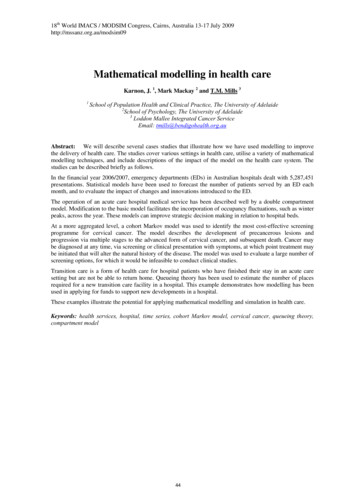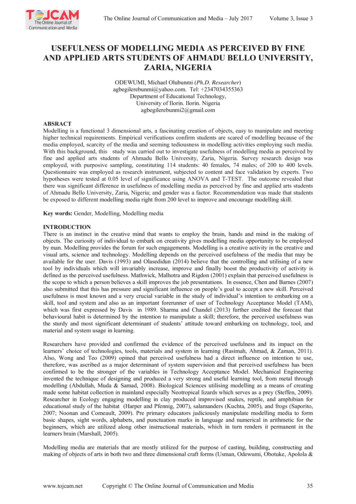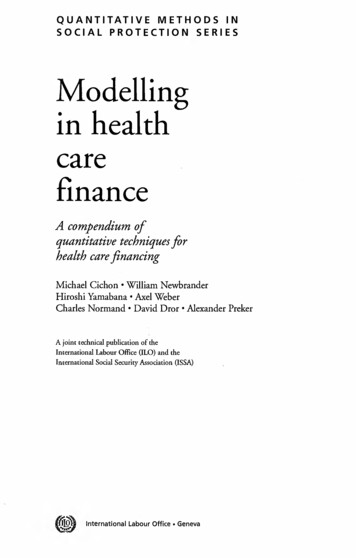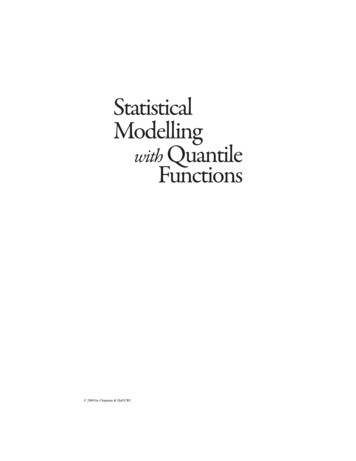
Transcription
18th World IMACS / MODSIM Congress, Cairns, Australia 13-17 July 2009http://mssanz.org.au/modsim09Mathematical modelling in health careKarnon, J. 1, Mark Mackay 2 and T.M. Mills 31School of Population Health and Clinical Practice, The University of Adelaide2School of Psychology, The University of Adelaide3Loddon Mallee Integrated Cancer ServiceEmail: tmills@bendigohealth.org.auAbstract: We will describe several cases studies that illustrate how we have used modelling to improvethe delivery of health care. The studies cover various settings in health care, utilise a variety of mathematicalmodelling techniques, and include descriptions of the impact of the model on the health care system. Thestudies can be described briefly as follows.In the financial year 2006/2007, emergency departments (EDs) in Australian hospitals dealt with 5,287,451presentations. Statistical models have been used to forecast the number of patients served by an ED eachmonth, and to evaluate the impact of changes and innovations introduced to the ED.The operation of an acute care hospital medical service has been described well by a double compartmentmodel. Modification to the basic model facilitates the incorporation of occupancy fluctuations, such as winterpeaks, across the year. These models can improve strategic decision making in relation to hospital beds.At a more aggregated level, a cohort Markov model was used to identify the most cost-effective screeningprogramme for cervical cancer. The model describes the development of precancerous lesions andprogression via multiple stages to the advanced form of cervical cancer, and subsequent death. Cancer maybe diagnosed at any time, via screening or clinical presentation with symptoms, at which point treatment maybe initiated that will alter the natural history of the disease. The model was used to evaluate a large number ofscreening options, for which it would be infeasible to conduct clinical studies.Transition care is a form of health care for hospital patients who have finished their stay in an acute caresetting but are not be able to return home. Queueing theory has been used to estimate the number of placesrequired for a new transition care facility in a hospital. This example demonstrates how modelling has beenused in applying for funds to support new developments in a hospital.These examples illustrate the potential for applying mathematical modelling and simulation in health care.Keywords: health services, hospital, time series, cohort Markov model, cervical cancer, queueing theory,compartment model44
Karnon et al., Mathematical modelling in health care1.INTRODUCTION“The enjoyment of the highest attainable standard of health is one of the fundamental rights of every humanbeing without distinction of race, religion, political belief, economic or social condition” (World HealthOrganisation (1946)). Thus, in its Constitution, the WHO places substantial responsibilities on the States thatare signatories to ensure the effective delivery of health care services in their countries.This paper summarises several case studies, in which the authors have been involved, that illustrate howmodelling and simulation can assist governments to carry out these responsibilities. The examples are set in avariety of contexts, namely, a hospital emergency department, patient flow in an acute hospital, a nationalscreening program for cervical cancer, and aged care. They employ a range of models including, time series,compartmental models, Markov chains and queueing models. In presenting each case study, we will give abrief introduction that sets the scene.Collectively, these short stories show the potential for modelling in a wide range of problems in health care.2.EMERGENCY MODELSOvercrowding in the emergency department (ED) of a hospital is a common occurrence. Most of us haveattended an ED either as a patient or carer and there is widespread appreciation of the problems and issues.Patients and carers are distressed—it is after all an emergency. Doctors and nurses seem to be run off theirfeet, perhaps at the end of a long shift. Decisions are often made quickly.A creative writer may see the makings of a TV program in all this. A mathematically minded observer maysee the ED as a fertile source of opportunities for modelling and simulation.This case study deals with two applications of modelling in the ED of an Australian hospital. First, timeseries models were used to forecast the demand for emergency services at the hospital. Second, regressionmodels were used to evaluate a new approach to managing patient flow in the ED. Both projects wereundertaken by multidisciplinary research teams from universities and the hospital.ForecastingWe cannot foresee falling over and breaking an arm, or cutting our hand in the kitchen while preparing ameal, or a child waking up in the night screaming with stomach pain. Emergencies are unpredictable.However, the number of patients who present themselves to the ED is quite predictable as a function of time.This thesis was the basis of the research reported in Champion et al. (2007).A research team of academics and clinicians set about exploring patterns of presentations at a hospital EDover several years. By regarding the number of presentations over time as a time series, one can apply modelsfrom time series analysis to the data. Although time series models provide an obvious approach to exploringED data, a review of the literature showed that these models have not been used often in this context.The main findings were as follows. The average number of presentations per day over a month did not varymuch with the month, although the variation was statistically significant. There are more obvious patterns inthe number of presentations per day over the seven days of the week. And there are clear patterns in thenumber of presentations per hour for the 24 hours over the day.One practical outcome of this work is that the hospital modified its staffing rosters in light of the arrivalpatterns discovered in the course of the project. The time series models led to accurate forecasts of thenumber of patients on a monthly basis. In the course of the study, the project threw up many more questions,and the team members developed a deeper appreciation of the data and models.EvaluationHospitals are continually exploring new ways to improve their services, and striving to develop innovationsthat are based on evidence from research. Innovations need to be evaluated and a typical approach issummarised by the following steps.1. Decide on a key performance indicator (KPI) that will reflect the quality of the service.2. Measure the KPI before the innovation is introduced.3. Measure it again some time after the innovation has been introduced.4. Compare the values of the KPI before and after the introduction of the innovation.This approach, common though it may be, has some obvious flaws. There is no control group against whichto compare the change in the experimental situation. In reality, it is very difficult to find a suitable control45
Karnon et al., Mathematical modelling in health caregroup when evaluating an innovation in a hospital. Also, it is often difficult to attribute the change in anindicator to the innovation because lots of things may be changing while the innovation is being considered.The following case study suggests that time series models are useful tools for evaluating innovations inhealth care.When a patient arrives at the ED, the first stop is at the triage desk. The triage nurse takes the patient’sdetails, assesses the urgency of the case, and assigns a triage rating in accordance with the Australian TriageScale. Then, patients are seen in order according to this triage rating.At the hospital where this study was conducted, a new approach to managing patient flow, known as“streaming”, was introduced. As usual, all patients receive a triage rating. In addition, the triage nurse woulddecide whether the patient required complex care or not. Patients who did not require complex care would betreated on a first-come-first-served basis; patients who required complex care would be treated according totheir triage rating. It is similar to having a fast queue in a supermarket for people who do not buy many items.Regression models were used to evaluate the streaming innovation (Kinsman et al. (2008)). The VictorianDepartment of Human Services has defined certain KPIs by which EDs are assessed. These KPIs wereselected as the response variables in the regression models. A dummy variable indicated whether theobservations were from a month before the innovation or a month after the innovation.This work demonstrated clearly to the hospital that streaming had a positive effect on the KPIs involved.There was considerable interest in these findings at the hospital because there are financial implications forthe hospital in meeting these government requirements. Furthermore, those associated with the project had abetter understanding of the role that mathematical models can play in evaluating innovations.SummaryThese examples in this first case study show the potential for applying mathematical modelling andsimulation in improving our understanding of patient flow in the ED of a hospital. The projects had practicaloutcomes that were of benefit to the hospital, and, during the course of the projects, many more interestingquestions and possible projects were uncovered.3.COMPARTMENTAL MODELSThis case study will describe the application of compartmental models in describing bed occupancy in anacute hospital.The increasing proportion of older people in Australia presents a range of challenges for communities andgovernments, including a period of greater expenditure on health and other social services. This challenge ismade even greater when combined with the shift in disease prevalence from acute infectious disease to one ofchronic disease (Generational Health Review, 2003; Productivity Commission, 2005).Health workers are also ageing and many will reach the end of their working lives within the next 8 years.The expected large number of retirements comes at a time of forecast high demand for services, a reductionof available workers and following a period of insufficient succession planning. Thus, there is a widening gapin the ability to supply services, both in terms of capital infrastructure and workforce.Hospital occupancy levels have also increased in recent years. The ability to provide services to the growingwave of baby boomers that are expected will not exist, ceterus paribus, unless capacity is increased.Additional capacity, in terms of capital infrastructure, can be created relatively quickly. There is, however,little point in doing so if there are insufficient staff available to provide services to patients.The forecast in future demand is of such concern that, in 2006, the South Australian Minister for Healthreported that there was solid evidence that if the State continued to provide health care using current modelsof service delivery and care strategies, by 2043 the entire state budget will be required to meet the costs ofproviding health care.Given the increasing demands being placed upon the health services and the likelihood of significant staffshortages, there are serious consequences in both economic resource allocation and patient (and population)health outcomes if decisions about future health service structures are incorrect. Given the recent advances incomputing power and the need to improve decision making, there has never been a more opportune time toapply modelling to facilitate improved decision making in the health care sector. One aspect where modellingwill become increasingly important in the health sector is in relation to modelling decisions around hospitalbeds.46
Karnon et al., Mathematical modelling in health careIn practice, decision making relating to hospital beds has often been based on either some “back of theenvelope” calculation or a “rule of thumb”. And these approaches have tended to rely on the average lengthof stay (ALOS) metric. The modelling of hospital beds and patient length of stay, which are intertwined, isnot new; see, for example, Yates (1982), Pendergast and Vogel (1988), and Sorensen (1996). It has beenrecognised that the use of the ALOS for modelling hospital bed issues is flawed; see, Farmer and Emami(1990), Harrison and Millard (199), Mackay and Millard (1999), and Costa et al. (2003). There are numericaland practical reasons that using the ALOS is inappropriate for use in the development of models, mostnotably that the typical length of stay distribution is highly skewed distribution and not well summarised byits mean value.Compartmental models offer an alternative approach. A compartmental model describes the flow ofsomething, such as patients, through a system, where the system is comprised of a finite number ofhomogeneous subsystems known as compartments. Godfrey (1983) is a standard text on these models.Harrison and Millard (1991) introduced compartmental models to describe patient flow. The hospital bedcompartmental flow model can be represented a shown in the Figure 1.C o m p a r t m e n tsP a t ie n ts e n te rt h e s y s te mC o m p a rtm e n t 1 –e .g . s h o r t s ta yp a ti e n t sP a ti e n t s le a v eth e s y s te mC o m p a rtm e n t 2 –e .g . lo n g s ta yp a t ie n t sP a ti e n t s l e a v eth e s y s t e mF lo w to n e x t c o m p a rtm e n tF lo w to n e x t c o m p a rtm e n tC o m p a rtm e n t nP a ti e n t s l e a v eth e s y s t e mFigure 1: A representation of the flow of patients through compartments. The compartments may be virtualor real - the patients may not actually change location within the physical hospital (Mackay and Lee, 2005).Work to date has focused on two or three compartment bed occupancy flow models to describe the patientstay profile within the hospital with additional compartments being added to incorporate the community. SeeHarrison (1994), Mackay (2001), McClean and Millard (1994, 1995, 1998), Taylor, McClean and Millard(1996), Harrison (2001).An application in Australia and New ZealandRecently, compartmental models have been applied to the acute care sector in Australia and New Zealand byMackay with others. See Mackay and Millard (1999), Millard, Mackay, Vasilakis and Christodoulou (2000),Mackay (2001), Mackay and Lee (2004a, 2004b, 2005), Mackay, Lee, Millard and Rae (2004), Harrison,Shafer and Mackay (2005), Mackay (2006).In his PhD thesis, Mackay (2007) explored whether the deterministic compartmental flow models of bedoccupancy, described by Harrison and Millard (1991) in an aged-care facility in the UK, could be adapted,and enhanced, for application in Australia and New Zealand. The research sought to answer the followingquestions. Can the compartmental flow models be successfully applied to the acute care data? Can the models be used for other purposes, such as forecasting, evaluation of service change, and theeffects of altering funding policy? Can bed occupancy compartmental flow model could be further developed to enable a better fit of thedata? Could sensitivity and simulation techniques be used to incorporate uncertainty?47
Karnon et al., Mathematical modelling in health careAdministrative data were obtained from an Australian and a New Zealand hospital containing patient date ofadmission and discharge. The occupancy data for a large period (e.g., a year) were summarised using theaverage and standard deviation. The number of data points was reduced to a matrix of 2 (average andstandard deviation) by approximately 100 (maximum time since admission) or 200 data points.Compartmental models were fitted to the data with the number of compartments varying between one andseven. The method of maximum likelihood was used to optimize the fit. The Bayesian information criterionprovided information about the level of fit and complexity; the absolute error only provided informationabout model fit to the data.ResultsThe acute care data from Australia and New Zealand was found to be well described by the compartmentalmodel. The question of model complexity was considered and when the issue of the value of additionalinformation about long-stay patients was taken into account, a two-compartment model of occupancy wasfound to describe the data sufficiently well.Harrison and Millard’s model was further developed to include other variables such as patient age,seasonality, and vacancy and to enable the application of simulation. Figure 2 summarises thesedevelopments.DiscussionThere is a continuum upon which decision making occurs. Strategic decision making is concerned withdecisions that will occur in a longer time frame whereas operational decision making relates to decisions thatcome into effect in a short space of time. Strategic and operational decision making criteria may share somecommon inputs, but this will not always be the case. The weight placed upon the common factors may bedifferent. Thus, it is likely that the models that can assist decision makers for strategic and tactical decisionmaking will be different.Compartmental models have the potential to contribute to improve decision making at the strategic level.They have the added advantage that they are easily interpreted by clinicians and decision makers.48
Karnon et al., Mathematical modelling in health careB a s e (A v e ra g e ) M o d e l o f T o ta l O c c u p a n c y9080Base modelM odelOccupancy - average70Y Ae-bx Ce-dx60D a ta50403020100JanFebM arAprM ayJunJulAugSepO ctN ovD ecN ovD ecM o n thB a s e ( A v e r a g e ) M o d e l o f T o ta l B e d O c c u p a n c y M o d if ie d f o r th e In f lu e n c e o f t h e W e a th e r908070M odelOccupancy - average60Weather modifiedmodelD a ta50403020100JanFebM arAprM ayJunJulAugSepO ctM o n thBase (Average) Model of Total Bed Occupancy Modified for theInfluence of the Weather and Vacancy10090Vacancy and weather adjusted80Weather andvacancy modifiedmodelOccupied OctNovDecMonthSimulation: 10,000 runs to Estimate Occupancy Required to Achieve Zero PatientTurn-Away120100Uncertaintyincorporated intothe modelOccupied onthModel occupancyMeanRange minimumRange maximumFigure 2: Development of the original deterministic compartmental model to incorporate seasonalvariation and variability of patient arrivals.4.SCREENING FOR CERVICAL CANCERMost developed countries to establish some form of publicly funded health care system. A common problemin such systems is that there is more demand for health care than could possibly be funded from the publicpurse, and so choices have to be made about what interventions are provided to which patients. Given theneed to distribute scarce resources, publicly funded health care systems generally have an objective ofmaximising the health benefits produced by the system (efficiency), subject to consideration of the equitableprovision of health care.Economic evaluation or cost-effectiveness analysis is a technique that estimates the costs and benefits ofalternative health care interventions to inform the efficient allocation of resources. Individual economicevaluations involve comparisons of alternative interventions for the same class of patients, for example,patients with early breast cancer. The results of individual evaluations are compared to determine the best useof resources across diseases.A simplified example of the resource allocation process is provided by a health care system in which thereare two diseases, with two treatment options for each disease. The respective costs and benefits (representedas units of health gain) are presented in Table 1. Treatments are not divisible, so that all patients in eachdisease group receive the same treatment. If the budget is 15,000, it is clear that health gains are maximisedby allocating resources to Treatments 1A and 2B (17 units of health gain compared to 14). More generally,49
Karnon et al., Mathematical modelling in health carewe can assess the relative value of the two more effective treatments (1B and 2B) by comparing theirincremental cost-effectiveness ratios (ICERs)where ICER is defined by:ICER Cost B Cost AHealth.Gain B Health.Gain AIn the example, the move from treatment 2A to 2B gains units of health at a cost of 500, whilst 1B gainsunits at a cost of 800, so 2B is more cost-effective than 1B. In a real health care system, where there aremany thousands of separate conditions to be treated, it is not possible to list the costs and benefits of allpossible treatments. Instead, we define a threshold value for the ICER that is assumed to represent the ICERof treatments that would be displaced in order to free-up funds to provide the treatment being evaluated. Ifthe ICER of the treatment being evaluated is under the threshold value, then it is defined as being costeffective.In order to provide a common basis for comparisons between treatment areas it is necessary to estimatedifferences in costs and benefits in a similar manner across evaluations. In practice, this means using ageneric measure of outcome (quality adjusted life years (QALYs)) and estimating costs and benefits over theremaining lifetime of the patient population. QALYs are estimated by applying utility weights to patients’survival that represents their health-related quality of life, where 0 and 1 are equivalent to death and perfecthealth, respectively. As an example, a patient living for 5 years in a health state equivalent to 80% as good asperfect health, followed by 5 years in a state 60% as good as perfect health is alive for 10 years, but gains 7QALYs.Clinical effectiveness is commonly established via randomised controlled clinical trials, but such studies aresubject to limited follow-up periods that generally preclude the estimation of lifetime costs and benefits. Inother cases it is either not practical or ethical to undertake clinical trials. In both cases, it is necessary foreconomic evaluations to synthesise data to predict the long terms costs and consequences of health careinterventions (Briggs et al. (2006)). The most common framework for such syntheses is a Markov model,though simulation techniques are also used for more complex scenarios.The model describes disease progression in a cohort of patients, represented as transitions between discretehealth states from the point at which treatment is implemented. Cost and utility weights are applied to eachhealth state, and summed over the time horizon of the model to estimate total costs and QALYs. The impactof treatment is described in terms of how it alters the pathway of progression between the defined healthstates.The following section provides a brief description of an economic evaluation of screening for cervical cancer,which informed the allocation of resources at a national level in the United Kingdom. Full details of thisevaluation are in a published monograph by Karnon et al. (2004).Model developmentThe research question was “What is the effectiveness and cost-effectiveness of liquid-based cytology forcervical screening compared with conventional smear testing?”A Markov process was used to describe the life experience of a cohort of women followed from age 18 to 95years, with respect to the incidence and progression of cervical cancer. Pre-invasive cancer was defined ascervical intraepithelial neoplasia (CIN), which may be of three levels - CIN1, CIN2, and CIN3. In theabsence of intervention, the disease is assumed to progress through each pre-invasive stage and from CIN3 toinvasive cancer, with the proviso that regression to a disease-free state may occur from CIN1 only. There issome evidence that the higher grades of CIN may also regress (Sherlaw-Johnson et al. (1994)), and thispossibility was explored in sensitivity analyses.The model calculates state transitions at intervals of six months, which were informed by an earlier stochasticmodelling study that had calibrated transition probabilities to observed estimates of the incidence of invasivecervical cancer (Sherlaw-Johnson et al. (1994)). Within any six-month interval, CIN lesions may progress tothe next immediate state, though a proportion of fast growing CIN1 lesions may directly progress to CIN3.Age-specific incidence rates for CIN1 were applied, but disease progression was assumed to be non-agespecific.A constant risk was assumed for mortality from invasive cancer, based on an average life expectancy withinvasive cancer in an unscreened population of approximately 10 years (Obralic et al. (1997)) and a meanduration pre-diagnosis of approximately 5 years. The model incorporated age-specific other cause mortality50
Karnon et al., Mathematical modelling in health careusing life tables produced by the Government Actuary’s Department (Government Statistical Service Reviewof the Registrar General).Upon the confirmed detection of a lesion (either through clinical presentation or via the screening program),treatment can be initiated with the intention of removing pre-invasive lesions or slowing the rate of progressof invasive lesions. Screening can be implemented at different time intervals, and the alternative screeningtests have different levels of accuracy for correctly detecting women with a cervical lesion (sensitivity) andidentifying women with no lesions (specificity). Thus, improvements in test sensitivity increase detectionrates, leading to earlier treatment, reduced disease progression, and improved survival and quality of life.The uptake rate of a screening programme was informed by a pilot screening study, and it was assumed thatwomen either attend screening at regular intervals or not at all. Both screening procedures produce aproportion of inadequate screens that require rescreening, which have cost consequences. Confirmation ofpositive screens involves a colposcopy, which was estimated to be 100% sensitive and specific. It was furtherassumed that all abnormalities found at colposcopy are treated.Total direct costs of screening, diagnosis and treatment are included within the model and estimated from thefollowing unit costs: conventional smear test, liquid-based cytology techniques, colposcopies, treatment ofpre-invasive lesions, and treatment of invasive cancer.Model validationReported incidence of invasive cervical cancers across all ages is 12 per 100,000 per annum (Office ofNational Statistics (1993)) which is comparable with the predicted incidence of 11.64 by the baseline model.The age-specific incidence figures predicted by the current model were compared with those predicted by analternative model (Myers et al. (2000) which showed that the two models predict virtually the same pattern ofincidence over a lifetime.ResultsTable 2 presents the cost and benefits (measured in years of life gained) for a cohort of 100,000 women aged18 years, over their remaining life time. The results show that when the cost-effectiveness ratios are reestimated to exclude dominated options, screening at a regular interval of three years using liquid basedcytology is cost-effective, whilst screening at 2-year intervals approaches a reasonable level of costeffectiveness.A wide range of sensitivity analyses were undertaken that investigated the impact of altering the values ofincidence rates for CIN1; disease progression rates; screening test sensitivity; rates of inadequate cervicalsmears; costs of screening; and discount rates. The impact of assuming regression from CIN2 and CIN3lesions was also tested. Finally, the impact of quality adjusting survival was also tested by applying utilitydecrements to time spent with invasive cancer, waiting for confirmation of borderline screening tests, andundergoing a colposcopy. Liquid based cytology remained cost-effective over all of these analyses, thoughthe optimal time period between screens varied.DiscussionThe case study model was developed as part of the independent process of health technology assessment thatis used to inform resource allocation decisions in the UK. The National Institute for Clinical Excellence(NICE) commissioned our research group at the University of Sheffield to undertake the study, which wasthen subjected to a process of external peer review. The revised report, National Institute for ClinicalExcellence (2000), was then presented to the NICE Technology Appraisal Committee, who “considered that,taking into account a number of factors – including the potential for increased sensitivity, reduction ofinadequate smears and probable improvements in laboratory efficiency – the LBC method was likely to becost effective compared with the Pap smear, despite its higher associated cost” (p. 14). They further statedthat the health service should “develop implementation plans for the adoption of LBC as the primary meansof collecting and processing samples” (p.16).This case study provides one example of the many model-based economic evaluations that have been used byNICE and other reimbursement committees, such as the Pharmaceuticals Benefits Advisory Committee inAustralia and the Canadian Expert Drug Advisory Committee. Modelling is an integral part of the resourceallocation process in these countries. Moreover, the need for such models will expand as policymakers realisethat explicit cost-effectiveness analyses should inform disinvestment decisions, as well as investmentdecisions.51
Karnon et al., Mathematical modelling in health careIn addition, the increased interest in public health interventions that aim to prevent, rather than cure, diseasewill require the development of new and more complex cost-effectiveness models. An example is an obesitymodel that we are currently developing that will link risk factors to obesity to the health consequences ofobesity at an individual level, and then combine individuals to describe the population effe
computing power and the need to improve decision making, there has never been a more opportune time to apply modelling to facilitate improved decision making in the health care sector. One aspect where modelling will become increasingly important in the health sector is in relation to modelling decisions around hospital beds. 46










